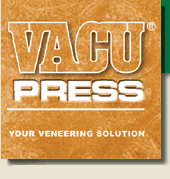Darryl Keil

Posts: 1455
Joined: 2003-05-22
Location: Maine
 User Profile User Profile |
Howard,
There really isnt a PVA glue designed for lower pressure, thats just a marketing strategy. I wouldnt go searching for that quality and its not really necessary anyway. Pretty much all PVA's bond at the same pressure and work well in a vacuum press because pressure is not the sole way they create a bond. Because vacuum draws the air out of the cell structure of the veneer and the air spaces in the substrate, glue is pulled in rather than having to be driven in. This in effect gives you the equivilent of much more pressure combined with the more obvious atmospheric pressure a vacuum press generates.
Back when we were first putting the vacuum press on the market I had some veneer samples tested at the wood reaserch lab at Syracuse University, one in a vacuum press, and one pressed conventionally at about 75psi. They examined the glue line thickness and penetration under the electron microsope,(I actually have the pictures)and you cannot tell the difference between the two. They were the ones who explained about the vacuum effect and why the samples looked the same despite the wide differeces in actual pressure.
I would instead look for a PVA with long open work time first, which is critical in my opinion. Unlike spreading glue for solid woodworking, veneer requires a thin even glue like which can tack rather quickly. Second, but not so important, would be a PVA with some fillers to minimize bleed through, provided you're working with commercially sliced veneer that is. Not something I'm personally concerned about but a lot of folks are.
Along with Veneer Systems, I really like Custom Pak Adhesives, they know their glues and would surely have a good PVA for you.
Remember that no PVA, no matter how much its been tweaked for veneer work, compares to the bond you get with a urea resin glue. Is there a reason you are choosing PVA over urea resin?
Sincerely
Darryl Keil
|





